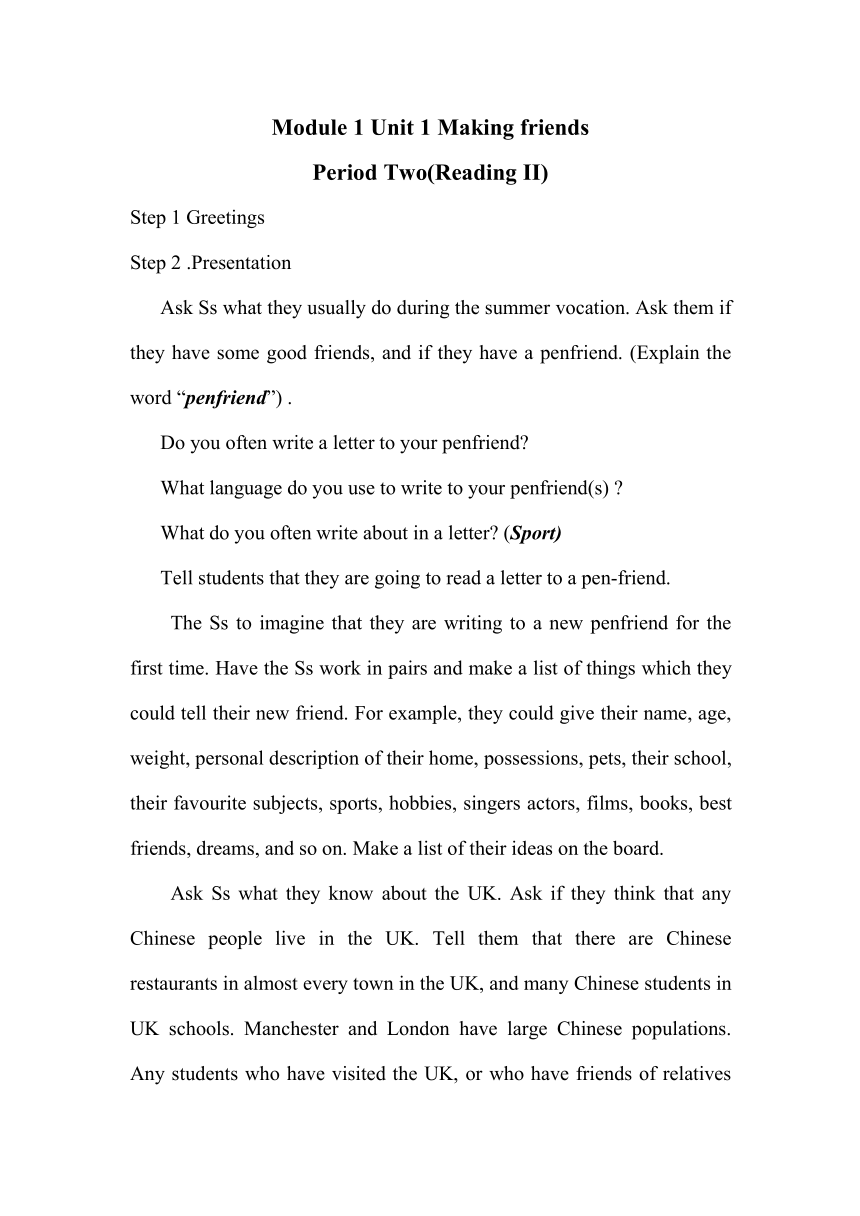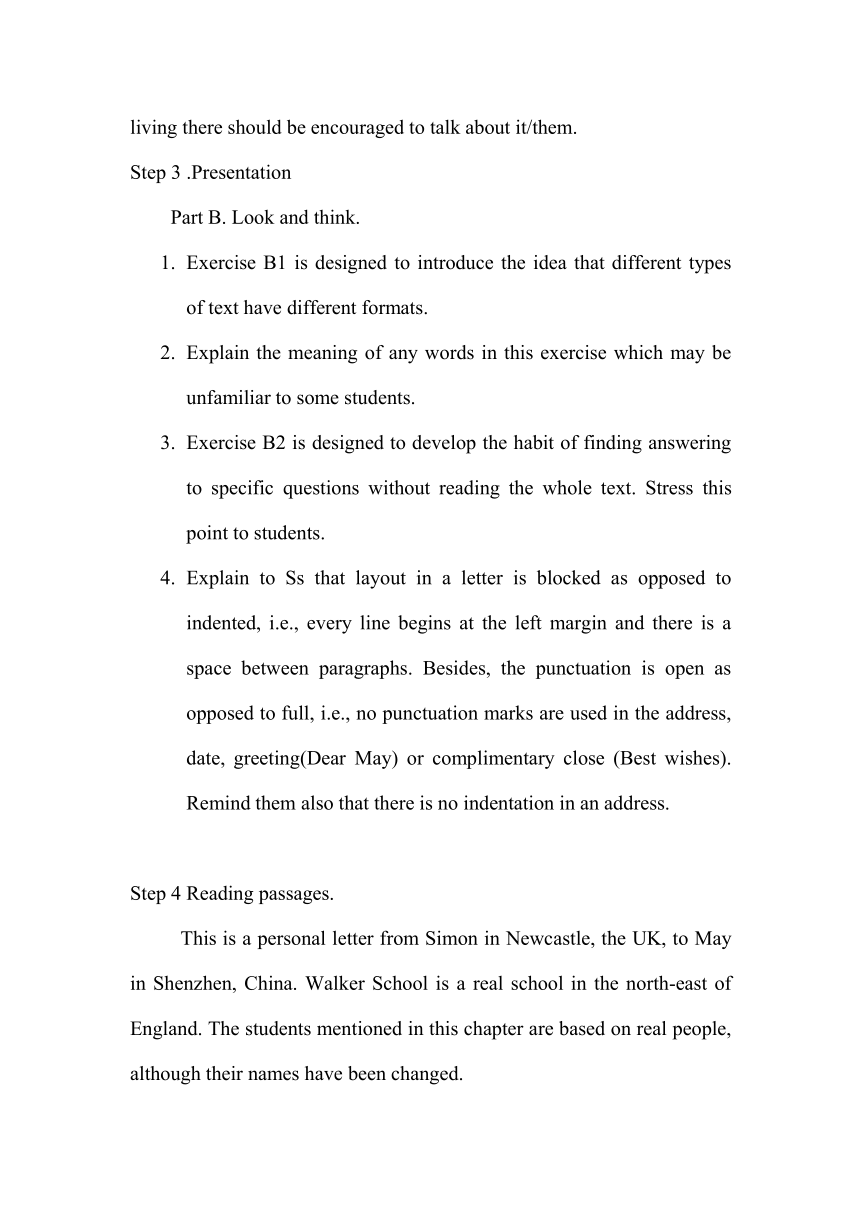广东省深圳市文汇中学七年级英语上册 Module 1 Unit 1 Making friends Period 2 复习教案
文档属性
| 名称 | 广东省深圳市文汇中学七年级英语上册 Module 1 Unit 1 Making friends Period 2 复习教案 |  | |
| 格式 | zip | ||
| 文件大小 | 119.7KB | ||
| 资源类型 | 教案 | ||
| 版本资源 | 牛津深圳版 | ||
| 科目 | 英语 | ||
| 更新时间 | 2017-07-20 00:00:00 | ||
图片预览


文档简介
Module
1
Unit
1
Making
friends
Period
Two(Reading
II)
Step
1
Greetings
Step
2
.Presentation
Ask
Ss
what
they
usually
do
during
the
summer
vocation.
Ask
them
if
they
have
some
good
friends,
and
if
they
have
a
penfriend.
(Explain
the
word
“penfriend”)
.
Do
you
often
write
a
letter
to
your
penfriend
What
language
do
you
use
to
write
to
your
penfriend(s)
What
do
you
often
write
about
in
a
letter
(Sport)
Tell
students
that
they
are
going
to
read
a
letter
to
a
pen-friend.
The
Ss
to
imagine
that
they
are
writing
to
a
new
penfriend
for
the
first
time.
Have
the
Ss
work
in
pairs
and
make
a
list
of
things
which
they
could
tell
their
new
friend.
For
example,
they
could
give
their
name,
age,
weight,
personal
description
of
their
home,
possessions,
pets,
their
school,
their
favourite
subjects,
sports,
hobbies,
singers
actors,
films,
books,
best
friends,
dreams,
and
so
on.
Make
a
list
of
their
ideas
on
the
board.
Ask
Ss
what
they
know
about
the
UK.
Ask
if
they
think
that
any
Chinese
people
live
in
the
UK.
Tell
them
that
there
are
Chinese
restaurants
in
almost
every
town
in
the
UK,
and
many
Chinese
students
in
UK
schools.
Manchester
and
London
have
large
Chinese
populations.
Any
students
who
have
visited
the
UK,
or
who
have
friends
of
relatives
living
there
should
be
encouraged
to
talk
about
it/them.
Step
3
.Presentation
Part
B.
Look
and
think.
Exercise
B1
is
designed
to
introduce
the
idea
that
different
types
of
text
have
different
formats.
Explain
the
meaning
of
any
words
in
this
exercise
which
may
be
unfamiliar
to
some
students.
Exercise
B2
is
designed
to
develop
the
habit
of
finding
answering
to
specific
questions
without
reading
the
whole
text.
Stress
this
point
to
students.
Explain
to
Ss
that
layout
in
a
letter
is
blocked
as
opposed
to
indented,
i.e.,
every
line
begins
at
the
left
margin
and
there
is
a
space
between
paragraphs.
Besides,
the
punctuation
is
open
as
opposed
to
full,
i.e.,
no
punctuation
marks
are
used
in
the
address,
date,
greeting(Dear
May)
or
complimentary
close
(Best
wishes).
Remind
them
also
that
there
is
no
indentation
in
an
address.
Step
4
Reading
passages.
This
is
a
personal
letter
from
Simon
in
Newcastle,
the
UK,
to
May
in
Shenzhen,
China.
Walker
School
is
a
real
school
in
the
north-east
of
England.
The
students
mentioned
in
this
chapter
are
based
on
real
people,
although
their
names
have
been
changed.
B3.
Tell
Ss
in
many
countries,
a
postal
code
is
part
of
a
person’s
address,
It
is
usually
a
group
of
letters
and
numbers.
What
is
Simon’s
postal
code
About
a
letter
Tell
the
students
that
the
passage
in
this
chapter
is
a
letter.
Question:
How
do
you
know
it
is
a
letter
Ask
the
students
to
finish
B
Look
and
think,
B1.
Explanation
on
some
new
vocabulary
items.
title
n.
the
name
of
something,
for
example
a
book,
film
or
picture
corner
n.
a
place
where
two
lines,
walls
or
roads
meet
at
the
top
right
corner
signature
n.
your
name
you
have
written
in
your
own
way
greetings
n.
words
that
you
write
to
somebody
at
a
special
time
A
postal
code
is
sometimes
an
important
of
a
letter.
In
many
countries,
a
postal
code
is
a
part
of
a
person’s
address.
In
China,
the
postal
code
is
a
group
of
six
numbers,
such
as,
200070.
In
some
other
countries,
a
postal
code
is
usually
a
group
of
letters
and
numbers.
A
postal
code
makes
it
easier
for
the
post
office
to
deliver
letter.
Explanation
on
‘postal
code’.
postal
a.
of
the
post
code
n.
a
way
of
writing
secret
messages,
using
letters,
numbers
or
special
signs
postal
code
deliver
v.
take
some-
thing
to
the
place
where
it
must
go
deliver
letters
Ask
the
students
to
write
out
Sidney’s
postal
code
in
B
Look
and
think,
B3,
on
page
3.
Skimming
the
passage
Say:
If
you
skim
a
passage
before
you
read
it,
you
can
get
a
general
idea
of
it.
Skimming
means
looking
at
titles
and
headings,
pictures
and
diagrams,
and
certain
sentences
in
the
passage
(e.g.,
the
first
and
last
sentences).
This
takes
only
a
minute
or
two,
and
it
helps
you
to
read
and
understanding
things
more
easily.
Ask
the
students
to
skim
the
letter
according
to
the
requirement
in
B
Look
and
think,
B2
on
page
2.
Check
the
answers
orally.
Homework
Finish
C
,D
,E
in
your
textbook
1
Unit
1
Making
friends
Period
Two(Reading
II)
Step
1
Greetings
Step
2
.Presentation
Ask
Ss
what
they
usually
do
during
the
summer
vocation.
Ask
them
if
they
have
some
good
friends,
and
if
they
have
a
penfriend.
(Explain
the
word
“penfriend”)
.
Do
you
often
write
a
letter
to
your
penfriend
What
language
do
you
use
to
write
to
your
penfriend(s)
What
do
you
often
write
about
in
a
letter
(Sport)
Tell
students
that
they
are
going
to
read
a
letter
to
a
pen-friend.
The
Ss
to
imagine
that
they
are
writing
to
a
new
penfriend
for
the
first
time.
Have
the
Ss
work
in
pairs
and
make
a
list
of
things
which
they
could
tell
their
new
friend.
For
example,
they
could
give
their
name,
age,
weight,
personal
description
of
their
home,
possessions,
pets,
their
school,
their
favourite
subjects,
sports,
hobbies,
singers
actors,
films,
books,
best
friends,
dreams,
and
so
on.
Make
a
list
of
their
ideas
on
the
board.
Ask
Ss
what
they
know
about
the
UK.
Ask
if
they
think
that
any
Chinese
people
live
in
the
UK.
Tell
them
that
there
are
Chinese
restaurants
in
almost
every
town
in
the
UK,
and
many
Chinese
students
in
UK
schools.
Manchester
and
London
have
large
Chinese
populations.
Any
students
who
have
visited
the
UK,
or
who
have
friends
of
relatives
living
there
should
be
encouraged
to
talk
about
it/them.
Step
3
.Presentation
Part
B.
Look
and
think.
Exercise
B1
is
designed
to
introduce
the
idea
that
different
types
of
text
have
different
formats.
Explain
the
meaning
of
any
words
in
this
exercise
which
may
be
unfamiliar
to
some
students.
Exercise
B2
is
designed
to
develop
the
habit
of
finding
answering
to
specific
questions
without
reading
the
whole
text.
Stress
this
point
to
students.
Explain
to
Ss
that
layout
in
a
letter
is
blocked
as
opposed
to
indented,
i.e.,
every
line
begins
at
the
left
margin
and
there
is
a
space
between
paragraphs.
Besides,
the
punctuation
is
open
as
opposed
to
full,
i.e.,
no
punctuation
marks
are
used
in
the
address,
date,
greeting(Dear
May)
or
complimentary
close
(Best
wishes).
Remind
them
also
that
there
is
no
indentation
in
an
address.
Step
4
Reading
passages.
This
is
a
personal
letter
from
Simon
in
Newcastle,
the
UK,
to
May
in
Shenzhen,
China.
Walker
School
is
a
real
school
in
the
north-east
of
England.
The
students
mentioned
in
this
chapter
are
based
on
real
people,
although
their
names
have
been
changed.
B3.
Tell
Ss
in
many
countries,
a
postal
code
is
part
of
a
person’s
address,
It
is
usually
a
group
of
letters
and
numbers.
What
is
Simon’s
postal
code
About
a
letter
Tell
the
students
that
the
passage
in
this
chapter
is
a
letter.
Question:
How
do
you
know
it
is
a
letter
Ask
the
students
to
finish
B
Look
and
think,
B1.
Explanation
on
some
new
vocabulary
items.
title
n.
the
name
of
something,
for
example
a
book,
film
or
picture
corner
n.
a
place
where
two
lines,
walls
or
roads
meet
at
the
top
right
corner
signature
n.
your
name
you
have
written
in
your
own
way
greetings
n.
words
that
you
write
to
somebody
at
a
special
time
A
postal
code
is
sometimes
an
important
of
a
letter.
In
many
countries,
a
postal
code
is
a
part
of
a
person’s
address.
In
China,
the
postal
code
is
a
group
of
six
numbers,
such
as,
200070.
In
some
other
countries,
a
postal
code
is
usually
a
group
of
letters
and
numbers.
A
postal
code
makes
it
easier
for
the
post
office
to
deliver
letter.
Explanation
on
‘postal
code’.
postal
a.
of
the
post
code
n.
a
way
of
writing
secret
messages,
using
letters,
numbers
or
special
signs
postal
code
deliver
v.
take
some-
thing
to
the
place
where
it
must
go
deliver
letters
Ask
the
students
to
write
out
Sidney’s
postal
code
in
B
Look
and
think,
B3,
on
page
3.
Skimming
the
passage
Say:
If
you
skim
a
passage
before
you
read
it,
you
can
get
a
general
idea
of
it.
Skimming
means
looking
at
titles
and
headings,
pictures
and
diagrams,
and
certain
sentences
in
the
passage
(e.g.,
the
first
and
last
sentences).
This
takes
only
a
minute
or
two,
and
it
helps
you
to
read
and
understanding
things
more
easily.
Ask
the
students
to
skim
the
letter
according
to
the
requirement
in
B
Look
and
think,
B2
on
page
2.
Check
the
answers
orally.
Homework
Finish
C
,D
,E
in
your
textbook
